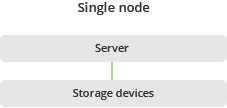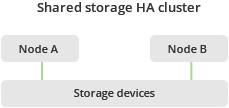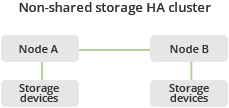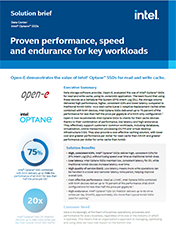Intel® Optane™ is a line of products based on 3D XPoint technology. The advantage of 3D XPoint over NAND is mainly based on addressing (for read and write operations) of single cells instead of whole blocks, where in order to perform a write operation, a whole sequence of read-modify-write operations have to be performed.
Intel® Optane™ SSDs are robust, stable, and high-performance data storage devices that are capable of functioning in even the most demanding data storage environments. The reliability and resiliency of Intel® Optane™ drives are a perfect complement for Open-E JovianDSS, especially as a cache device.
Open-E JovianDSS is based on ZFS, which provides advanced caching functionalities. The cache is processed in ZFS in the following ways:
-
First Read Cache level in RAM (ARC - Adaptive Replacement Cache).
-
Second Read Cache level on fast memory device (eg. SSD) (L2ARC – Level 2 Adaptive Replacement Cache)
-
Write Log - ZFS Intent Log (ZIL) located on separated fast memory device (SLOG)
Technologies of Intel® Optane™ and ZFS caching are a perfect fit that greatly enhances the crucial parameters of the whole data storage solution.
Benefits of using Intel® Optane™ SSDs
/ compared to NAND based SSDsHigh and Stable write IOPS
It’s well known that cache functionality requires ultra-fast random IOPS devices. Intel® Optane™ is able to provide that making it a perfect enhancement for ZFS-based data storage systems. It works stable on the same and very high IOPS level all over the time, while NAND SSD works fast at the beginning and then slows down.
Low and stable latency
Latency of NAND SSDs grows over time whereas latency of Intel® Optane™ SSD is significantly lower and is stable over time. Latency is extremely important when writing large amounts of small files, especially in database, virtualization, online transaction processing and desktop virtualization systems.
High Quality of service (QoS)
Due to significant simplification and thus shortening of write operation, the Intel® Optane™ disk offers significantly lower and stable latency which results in improving the QoS factor since more write operations are handled in a lower and narrower latency time period.
Extended lifetime
Unlike regular NAND SSDs, Intel® Optane™ SSDs are much more durable. The factor which is killing NAND SSDs is the amount of writes, especially liable in case of write cache functionality. Intel® Optane™ exceeds NAND durability several orders of magnitude, offering endurance up to 60 DWPD (Device Write Per Day) over 5 years.
Capacity storage tier protection
Thanks to utilizing Intel® Optane™ drives as a write log, HDD drives serving as main data storage are protected from extensive write operations. The same benefit is with all-flash storage based on regular NAND SSDs used as a capacity storage tier - Intel® Optane™ used as a write log protects the NAND memory and extends its lifetime thanks to more sequential and less frequent writes.
Cost-effective RAM cache replacement
As a read cache, Intel® Optane™ drives significantly lower server costs since it is a good replacement of ECC RAM. In such a case, it is not as fast as ECC RAM but it serves its purpose. In certain configurations, large amounts of ECC RAM (used for ARC) can be replaced with small amounts of ECC RAM together with Intel® Optane™ (used for L2ARC) giving huge cost savings while simultaneously providing minor decreases in speed.
Perfect solution for various storage configurations
Intel® Optane™ SSDs are perfectly capable of working in all Open-E JovianDSS storage architectures:







